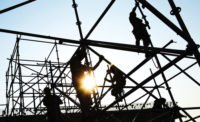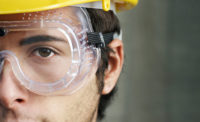A NIOSH Science Blog post
Traumatic brain injuries in construction

Falling 25 feet to the ground from a roof, being struck in the head by a steel beam as it is transported across a worksite, or getting hit by a vehicle moving supplies–these are only a few examples of why the construction industry has the greatest number of both fatal and nonfatal traumatic brain injuries (TBIs) among U.S. workplaces. From 2003 to 2010, 2,210 construction workers died because of a TBI (a rate of 2.6 per 100,000 FTE workers). These deaths represented 25% of all construction fatalities and 24% of all occupational TBI fatalities during the same period.
The numbers are tragic but there is some good news: the rate of fatal TBIs in construction decreased by 6.2% each year between 2003 and 2010. Some of this decline can be attributed to the overall decline in the rates of work-related deaths and fatal TBIs (including that are both work- and nonwork-related). Another reason is that spending and employment in construction decreased when the economic recession hit in 2007 resulting in fewer workers exposed to construction hazards. Despite these declines, TBIs remain one of the major causes of deaths in the construction industry.
How common are TBIs in construction?
Researchers at the National Institute for Occupational Safety and Health (NIOSH) recently took a close look at deaths due to TBIs in the construction industry in the United States during 2003 to 2010. Their 2016 report in the American Journal of Industrial Medicine describes findings such as these:
- Workers in small construction companies (<20 employees) were more than 2.5 times more likely than those in larger companies (≥100 employees) to die from a TBI.
- Males were 7 times more likely than females to die from a TBI.
- Older workers (≥65 years) were almost 4 times more likely than younger workers (25–34 years) to have a fatal TBI.
- The TBI fatality rate was significantly higher for foreign-born than for native-born workers.
- Falls, especially from roofs, ladders, and scaffolds, led to >50% of fatal work-related TBIs.
- Structural iron and steel workers and roofers had the highest fatal TBI rate, and TBIs related to falls caused most of their deaths.
How do we protect workers from TBIs?
Armed with the data above, safety and health professionals can work to prevent fatal TBIs in construction. A nationwide construction falls-prevention campaign, started by NIOSH, OSHA, and the CPWR—The Center for Construction Research and Training, seeks to raise awareness by encouraging everyone in construction to work safely and use the right safety equipment while working at heights, such as on roofs, ladders, and scaffolds. The Safety Stand-Down, stemming from the campaign, will occur during May 2-6, 2016. Also, to prevent falls from ladders, a NIOSH smartphone application provides visual and audio signals and safety tips for safe ladder positioning has been downloaded to over 63,000 smartphones as of January 31, 2016.
Improved harness sizing designs for protecting workers from falls due to poor fit or improper size selection; and a worker-support bracket and safety rail assembly that provides a guardrail system to protect workers from falling through unprotected roofs are among a few other NIOSH research studies that address falls.
Construction is a dangerous industry, and its workers are at high risk for TBIs and their life-threatening or life-long consequences. Thus, despite the drop in fatal TBI rates in construction, prevention efforts addressing these injuries continue to be implemented and improved, especially among high-risk workers.
Visit the campaign site for more information on preventing fall injuries in construction.
Looking for a reprint of this article?
From high-res PDFs to custom plaques, order your copy today!





